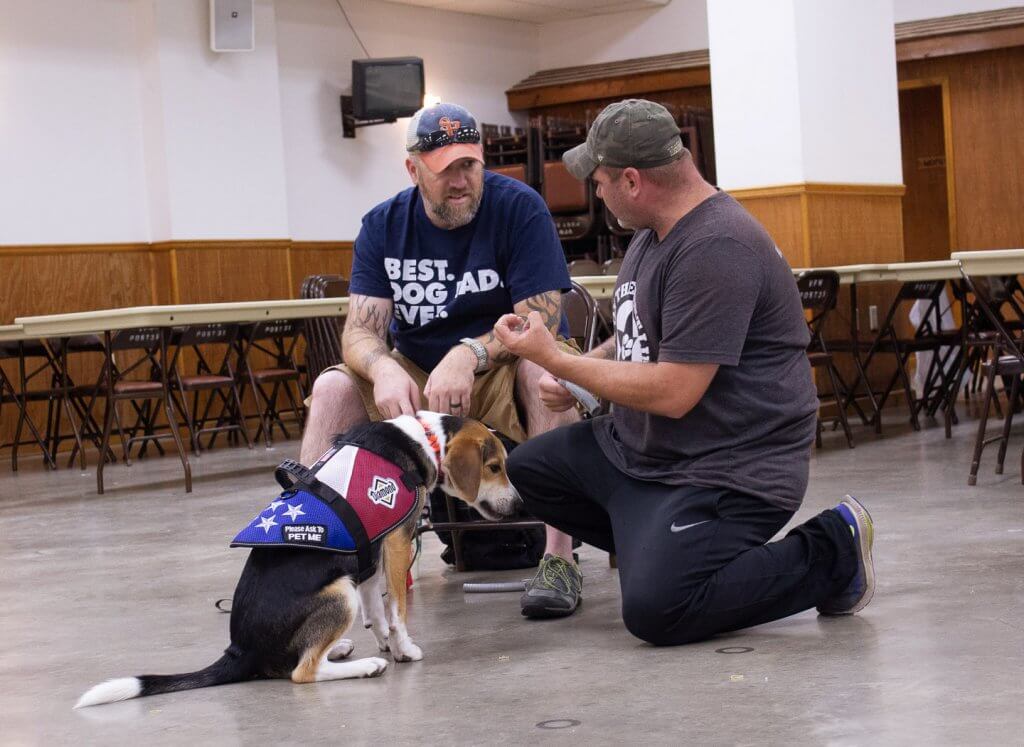“Before I had Sobee, I would hibernate in my house, with the curtains drawn, afraid to leave the house, as I felt like society didn’t understand me – it was safe and out of the public’s eye,” said Navy veteran Jason Howe. “That all changed immediately after being partnered with Sobee by K9s on The Front Line.”

With the Department of Veterans Affairs reporting that almost one-third of veterans suffer from PTSD, it’s important to take note of all the treatment options available. The use of service dogs is one of those options, and a recent study from Purdue University indicates that service dogs can help lower depression and increase satisfaction in the lives of veterans.
How, exactly, do dogs help?
Army veteran Jerimiah Church struggled with his transition from military service to civilian life. “I felt as if I had no purpose, I never wanted to leave the house, and was really, just miserable,” he said.
Now with his dog Que Vadis, whom he calls Que, by his side, he’s able to conquer some of those obstacles that made him feel trapped.
“Que acts as my ambassador, as the buffer between other people and me. Because people notice him first, it allows me time to gather myself before interacting,” Church said. Que helps Church in many ways,sometimes by forcing him to play to look past anxiety and sometimes by taking the attention off of Church when they are out in public.
“Que is very in tune with my mental health and can act in a way that helps me take my mind off of what I am worried about.”
Finding the right organization
Church, like most veterans struggling in transition or suffering from PTSD, was hesitant to the idea. His wife actually tricked him into thinking they were going to breakfast when instead they met with Hagen Blaszyk, co-founder of K9s on the Front Line. “After spending a few hours with the puppies, I was convinced,” Church said. “I entered the program and was eventually matched with Que.”
In 2016, K9s on the Front Line began, with immediate and dramatic results. Jason Howe, Navy veteran, owes a lot to the organization. When he left the Navy and moved home to Gardiner, Maine, he was introduced to the program, which he credits with saving his life. “Not only did K9s on the Front Line save my service dog, Sobee, who was two days away from being euthanized, but they also saved my life too. Sobee gave me a purpose to wake up every morning.”
Veterans like Howe and Church, who may feel like they have nowhere else to turn are encouraged to contact K9s on the Front Line. The program does require quite a bit of work, however.
“Once a match between a veteran and service dog has been made, they are placed together immediately, meaning the veterans become their service dog’s trainers and handlers. Although this puts more responsibility on the veterans, it gives them the sense of purpose they’ve been looking for and allows them to create a special bond and trust with each other throughout the process,”Howe said.
What does the process look like?
K9s on the Front Line has a 16-week training program, which includes weekly classes and 120 training hours for the four to six veterans in each class. Throughout the training, there are field trips, which allow the veterans and their K9s to put their training to work. For veterans who already have a dog at home, there is an option to have that dog become your K9. Otherwise, a K9 with the appropriate temperament and size can be found to match the veteran’s desires and needs.
When Sobee and Howe graduated from the program, they moved back to Jefferson, Miss. and started a branch there. The success Howe has seen proves the need for veteran and K9 support. “We have been welcomed into the community by so many people, such as the mayor and several Missouri based companies, like Diamond Pet Foods and Veterans United Foundation as all have shown support to our organization.”
“The Navy taught me structure and gave me a mission to wake up to every day,” Howe said.
Now he finds that mission in working with K9s on the Front Line and helping other veterans work through their transition to civilian life. To learn more about K9s on the Front Line and how you can be a part of the program, visit their website.

